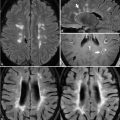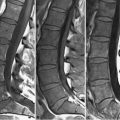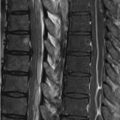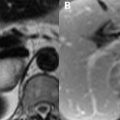84 Glenohumeral Instability II, Labrum Additional causes of anterior glenohumeral stability include Bankart variants of which the Perthes lesion is an example. This lesion occurs when the scapular periosteum remains intact but is stripped medially, while the anterior labrum is avulsed from the glenoid but remains partially attached to the scapula by the intact periosteum. The labrum may assume a normal position and thus a Perthes lesion is difficult to diagnose without imaging the shoulder in abduction and external rotation. A Perthes lesion is illustrated in the MR arthrogram image (FS T1WI) of Fig. 84.1. Here, contrast undermines the anterior labrum with stripping of the glenoid periosteum. There is not significant displacement of the former structure, and in distinction to the Bankart lesion (see Fig. 83.1B), the attachment of the labrum to the periosteum remains intact. Disruption of the scapular periosteal attachment is also characteristic of anterior labral ligamentous periosteal sleeve avulsion injury (ALPSA), which is essentially a Bankart lesion in which the torn fragment of the anterior labrum is displaced medially and rotated inferiorly (a “medialized” Bankart). Similar lesions may be seen with the posterior labrum and may be referred to as POLPSA (posterior periosteal sleeve avulsion). Avulsions of the anterior band of the inferior glenohumeral ligament may occur at its humeral attachment (HAGL), although midportion tears are more common. On conventional MRI, these lesions are difficult to detect in the absence of a joint effusion but may appear as foci of hyperintensity on T2WI, the T1WI typically demonstrating a thickened, irregular ligament. Arthrographic findings include extravasation of contrast material within the ligament at its humeral attachment. The inferior displacement of the ligament characteristically results in a J shape. Posterior HAGL lesions (PHAGL) are less common and consist of avulsions of the posterior band of the inferior glenohumeral ligament at its humeral attachment. Associated marrow edema or humeral bone avulsions may occur with both of these lesions and are sometimes referred to as BHAGL.
Stay updated, free articles. Join our Telegram channel

Full access? Get Clinical Tree








